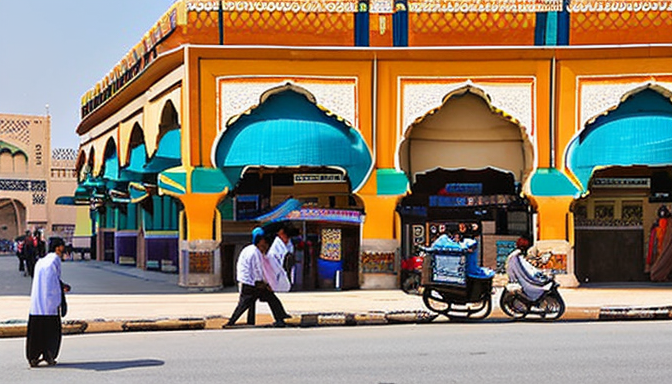Karachi, a bustling metropolis, is a city where the past and present dance together. Its colonial history isn’t just a chapter in a dusty book; it’s woven into the very fabric of daily life. When you stroll through the streets, you can’t help but notice the impressive colonial architecture standing tall amidst modern buildings. These structures tell stories of a time when the British ruled, leaving behind a legacy that still shapes the city today.
Take a moment to look at the grand Frere Hall or the elegant Mohatta Palace. Each brick and archway reflects a blend of Gothic, Indo-Saracenic, and Victorian styles. This architectural mix is not just about aesthetics; it influences how urban planning evolves. Today’s architects often draw inspiration from these historical designs, creating a unique skyline that honors its roots while embracing the future.
But it’s not just the buildings that echo the past. The policies enacted during colonial times laid the groundwork for Karachi’s development. Infrastructure projects initiated by the British set the stage for today’s bustling ports and roads. These decisions, while controversial, have undeniably shaped the city’s growth.
So, next time you find yourself in Karachi, take a moment to appreciate the layers of history around you. The colonial echoes are not just remnants; they are vibrant threads in the city’s ongoing story.
Architectural Heritage
The colonial past of Karachi is like a rich tapestry, woven with threads of British influence. As you stroll through the city, you can’t help but notice the stunning colonial architecture that stands tall, whispering stories of a bygone era. Buildings such as the Frere Hall and the Mohatta Palace are not just structures; they are symbols of a time when Karachi was a bustling hub under British rule.
These architectural gems showcase a blend of Gothic, Indo-Saracenic, and Victorian styles. Each style tells a story, revealing how the British adapted to local conditions while leaving their mark. For instance, the use of large verandas and high ceilings was a response to Karachi’s hot climate. Isn’t it fascinating how architecture can reveal so much about culture and climate?
Moreover, the policies during the colonial era shaped the urban landscape significantly. The British implemented city planning strategies that emphasized infrastructure and public spaces. This laid the groundwork for modern urban development. Today, Karachi’s bustling streets and vibrant neighborhoods can trace their roots back to these early policies.
In summary, Karachi’s architectural heritage is not merely about old buildings. It’s about understanding the intricate layers of history that have shaped the city we know today. So next time you admire a colonial structure, remember, it’s more than just a pretty facade; it’s a lasting echo of Karachi’s rich past.

Cultural Influences
The colonial era of Karachi was not just a period of governance; it was a time that profoundly shaped the city’s cultural identity. Imagine walking through the bustling streets of Karachi today, where the echoes of the past still resonate in the vibrant life around you. The influence of British rule is evident in many aspects of daily life. From language to food, the colonial legacy is interwoven with the local culture.
One of the most notable impacts is seen in the language. English became a prominent medium of communication, and it continues to play a significant role in education and business. This blend of Urdu and English creates a unique linguistic landscape. Have you ever heard someone switch between languages mid-sentence? It’s a common sight here, showcasing how deeply these cultures have fused.
Food, too, tells a story of cultural amalgamation. Karachi’s culinary scene is a delightful mix of flavors. Dishes like Karachi biryani and fish and chips reflect this blend. The colonial influence introduced new ingredients and cooking techniques, enriching local cuisine. You can find street vendors serving everything from spicy chaat to savory pav bhaji, each bite a reminder of the city’s diverse heritage.
In essence, Karachi stands as a living museum. Its streets, markets, and homes tell tales of a colonial past that shaped its present. This intricate tapestry of influences makes Karachi not just a city, but a vibrant cultural mosaic where history and modernity coexist.
Frequently Asked Questions
- What is the significance of colonial architecture in Karachi?
The colonial architecture in Karachi is a window into the city’s rich history. It showcases a unique blend of styles that not only reflect the past but also influence modern urban planning and design. Walking through the city, you can see how these historical buildings create a captivating narrative of Karachi’s evolution.
- How has colonial history influenced Karachi’s culture?
Colonial rule brought a fusion of cultural elements that have woven themselves into the very fabric of Karachi. From language to cuisine, the impact is profound. For example, the spicy flavors of local dishes often reflect a mix of indigenous and colonial influences, making the city’s food scene incredibly diverse and vibrant.
- Are there any modern initiatives to preserve colonial heritage in Karachi?
Yes! Many organizations and local governments are actively working to preserve colonial heritage sites. This includes restoration projects and awareness campaigns aimed at educating the public about the importance of maintaining these historical landmarks for future generations.